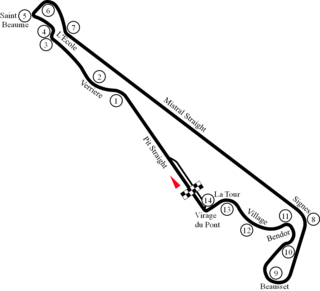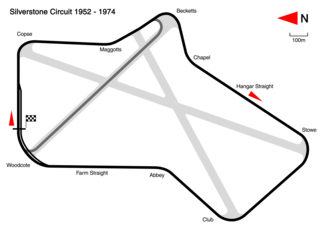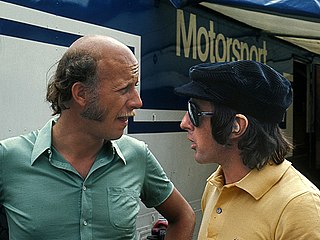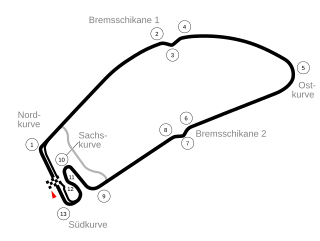
The Italian Grand Prix is the fifth oldest national motor racing Grand Prix, having been held since 1921. Since 2013, it has been the Grand Prix held the most times, with 94 editions as of 2024. It is one of the two Grands Prix which has run as an event of the Formula One World Championship Grands Prix every season, continuously since the championship was introduced in 1950. Every Formula One Italian Grand Prix in the World Championship era has been held at Monza except in 1980, when it was held at Imola.

Albert François Cevert was a French racing driver, who competed in Formula One from 1969 to 1973. Cevert won the 1971 United States Grand Prix with Tyrrell.

The 1971 South African Grand Prix, formally the Fifth AA Grand Prix of South Africa, was a Formula One motor race held at Kyalami Circuit on 6 March 1971. It was race 1 of 11 in both the 1971 World Championship of Drivers and the 1971 International Cup for Formula One Manufacturers. The race was won by Mario Andretti who was driving for the Ferrari team in what was his first Formula One victory, but would not win another Formula One race until 1976.

The 1971 French Grand Prix was a Formula One motor race held at the Circuit Paul Ricard on 4 July 1971. It was race 5 of 11 in both the 1971 World Championship of Drivers and the 1971 International Cup for Formula One Manufacturers. The 55-lap race was won by Tyrrell driver Jackie Stewart after he started from pole position. His teammate François Cevert finished second and Lotus driver Emerson Fittipaldi came in third.

The 1971 British Grand Prix was a Formula One motor race held at Silverstone on 17 July 1971. It was race 6 of 11 in both the 1971 World Championship of Drivers and the 1971 International Cup for Formula One Manufacturers. The 68-lap race was won by Tyrrell driver Jackie Stewart after he started from second position. Ronnie Peterson finished second for the March team and Lotus driver Emerson Fittipaldi came in third.

The 1971 German Grand Prix was a Formula One motor race held at Nürburgring on 1 August 1971. It was race 7 of 11 in both the 1971 World Championship of Drivers and the 1971 International Cup for Formula One Manufacturers.

The 1971 Austrian Grand Prix was a Formula One motor race held at Österreichring on 15 August 1971. It was race 8 of 11 in both the 1971 World Championship of Drivers and the 1971 International Cup for Formula One Manufacturers. The 54-lap race was won by BRM driver Jo Siffert after he started from pole position. Emerson Fittipaldi finished second for the Lotus team and Brabham driver Tim Schenken came in third. This was the debut race of the future world champion Niki Lauda.

The 1971 United States Grand Prix was a Formula One motor race held on October 3, 1971, at the Watkins Glen Grand Prix Race Course in Watkins Glen, New York. It was race 11 of 11 in both the 1971 World Championship of Drivers and the 1971 International Cup for Formula One Manufacturers. The 59-lap race was won by Tyrrell driver François Cevert after he started from fifth position. Jo Siffert finished second for the BRM team and March driver Ronnie Peterson came in third.

The 1972 South African Grand Prix, formally the Sixth AA Grand Prix of South Africa, was a Formula One motor race held at Kyalami on 4 March 1972. It was race 2 of 12 in both the 1972 World Championship of Drivers and the 1972 International Cup for Formula One Manufacturers. The 79-lap race was won by McLaren driver Denny Hulme after he started from fifth position. Emerson Fittipaldi finished second for the Lotus team and McLaren driver Peter Revson came in third.

The 1974 Argentine Grand Prix was a Formula One motor race held in Buenos Aires on 13 January 1974. It was race 1 of 15 in both the 1974 World Championship of Drivers and the 1974 International Cup for Formula One Manufacturers. The 53-lap race was won by McLaren driver Denny Hulme after he started from tenth position. Niki Lauda finished second for the Ferrari team and his teammate Clay Regazzoni came in third.

The 1974 Formula One season was the 28th season of FIA Formula One motor racing. It featured the 1974 World Championship of F1 Drivers and the 1974 International Cup for F1 Manufacturers, contested concurrently over a fifteen-race series which commenced on 13 January and ended on 6 October. The season also included three non-championship races.

The 1973 Formula One season was the 27th season of FIA Formula One motor racing. It featured the 1973 World Championship of Drivers and the 1973 International Cup for F1 Manufacturers, which were contested concurrently over a fifteen-race series that commenced on 28 January and ended on 7 October. The season also included two non-championship races which were open to both Formula One and Formula 5000 cars.

The 1972 Formula One season was the 26th season of the FIA's Formula One motor racing. It featured the 23rd World Championship of Drivers, the 15th International Cup for F1 Manufacturers, and numerous non-championship Formula One races. The World Championship commenced on 23 January and ended on 8 October after twelve races.

The 1971 Formula One season was the 25th season of the Fédération Internationale de l'Automobile's Formula One motor racing. It featured the 22nd World Championship of Drivers, the 14th International Cup for F1 Manufacturers and a number of non-championship races open to Formula One cars. The World Championship was contested over eleven races between 6 March and 3 October.

The 1970 Formula One season was the 24th season of the Fédération Internationale de l'Automobile's Formula One motor racing. It featured the 21st World Championship of Drivers, the 13th International Cup for F1 Manufacturers and three non-championship races open to Formula One cars. The World Championship was contested over thirteen races between 7 March and 25 October.

Peter Kenneth Gethin was a British racing driver and motorsport executive, who competed in Formula One from 1970 to 1974. Gethin won the 1971 Italian Grand Prix with BRM.

The Jochen Rindt Memorial or the VI Rhein-Pokalrennen was a motor race, run to Formula One rules, held on 13 June 1971 at the Hockenheimring, Germany. The race was run over 35 laps of the circuit, and was dominated by Belgian driver Jacky Ickx in a Ferrari 312B.

The BRM P160 was a Formula One racing car designed by Tony Southgate for the British Racing Motors team, which raced in the 1971, 1972, 1973 and 1974 Formula One seasons. It was powered by a 3.0-litre V12 engine.

The March 701 is a Formula One racing car model, designed by Robin Herd with Peter Wright, and built by March Engineering. The 701 was March's first Formula One design – following their one-off March 693P Formula Three prototype of 1969 – and was designed and built in only three months. The March 701 made its race debut a month after its public unveiling, at the 1970 South African Grand Prix. In total, eleven 701s were constructed, with March supplying many privateer entrants as well as their own works team. The 701's career started well, March drivers taking three wins and three pole positions from the car's first four race entries, but lack of development through the 1970 Formula One season resulted in increasingly poor results as the year wore on. The 701 was superseded by the March 711 in 1971, and made its last World Championship race appearance at the 1971 Italian Grand Prix.

The Tyrrell 002 is a Formula One racing car which was designed for the 1971 and 1972 Formula One seasons by Tyrrell's Chief Designer, Derek Gardner. It was essentially the same design as the Tyrrell 001, but incorporated some detail changes, and 002 were built with longer monocoques, as François Cevert was taller than Jackie Stewart.



















